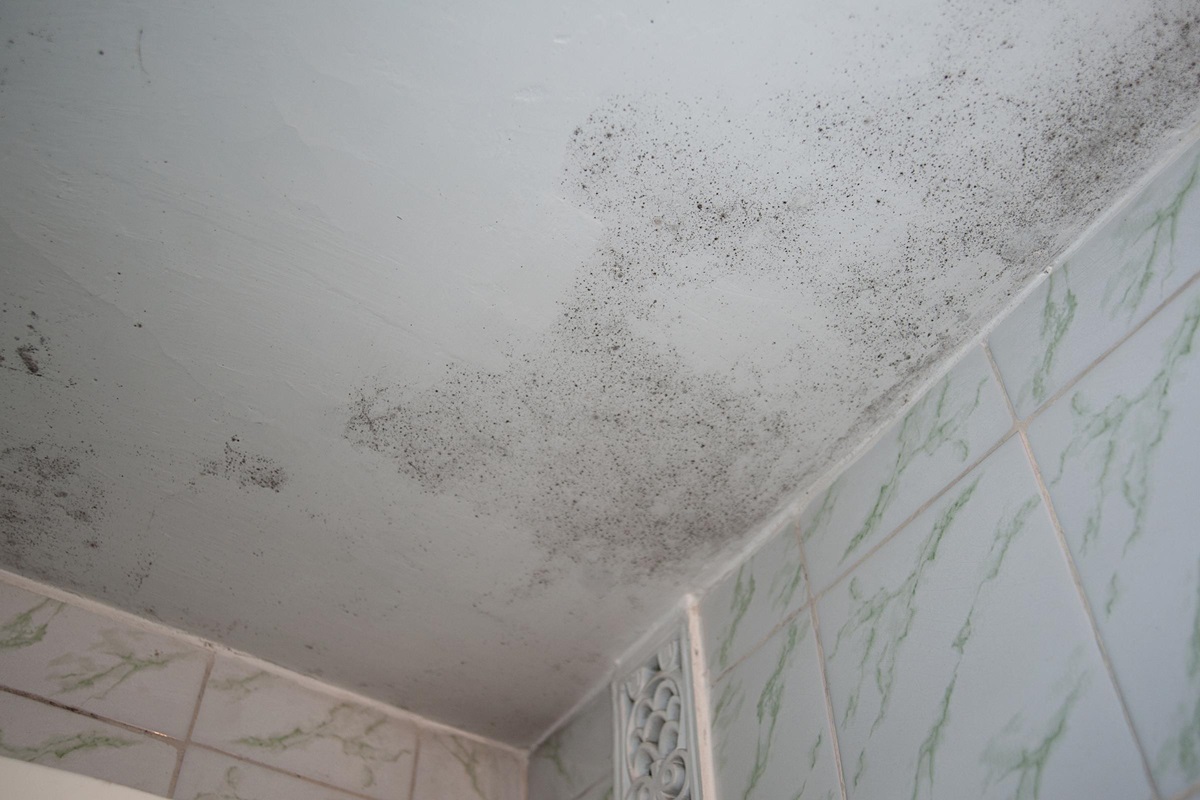Tips To Get Rid Of Mold From Your Bathroom Ceiling
Mold in your bathroom can be a big problem. It can make your home look dirty and cause health issues. If you see mold on your bathroom ceiling, don’t worry! You can clean it up with a few simple steps. This guide will show you how to do it safely and effectively.
Why Mold Grows In Bathrooms
Bathrooms are a perfect place for mold to grow. The warm, damp air from showers and baths can make the perfect home for mold. Mold likes to grow in dark, wet places. That’s why you often find it in bathrooms, especially on the ceiling.
Mold thrives in moist environments. Bathrooms, with their frequent use of water, provide an ideal environment for mold spores to settle and grow. Mold can appear as black, green, or even white patches on the ceiling. It often smells musty. If not fixed, it can harm health, especially for those with allergies or breathing problems.
What Supplies You Will Need For Mold Removal
Before you start cleaning, make sure you have everything you need. Here’s a list of supplies:
- Rubber gloves: To keep your hands safe. Mold can be irritating to the skin, and gloves help protect you from coming into direct contact with it.
- Safety goggles: To protect your eyes. Cleaning solutions can splash, and goggles will keep your eyes safe from irritants.
- Mask: To avoid breathing in mold spores. Mold spores can cause respiratory issues, so a mask helps protect your lungs.
- Ladder: To reach the ceiling safely. Ensure your ladder is stable and positioned correctly to avoid accidents.
- Scrub brush or sponge: For scrubbing the mold. A brush can help reach into crevices, while a sponge is good for smooth surfaces.
- Spray bottle: To apply the cleaning solution. A spray bottle helps you evenly distribute the cleaner over the moldy area.
- Cleaning solutions: You can use vinegar, bleach, or hydrogen peroxide. Each solution has its strengths:
- Vinegar: A natural option that works well for light mold. It also helps to deodorize the area.
- Bleach: Effective for killing mold on hard surfaces but can be harsh. Use it in well-ventilated areas.
- Hydrogen Peroxide: Good for killing mold and is less harsh than bleach.
The Process Of Cleaning Mold From Your Bathroom Ceiling
1. Prepare the Area
Before you start cleaning, you need to get the area ready. Here’s what to do:
- Turn off any fans: Fans can spread mold spores around the room. Turn them off to keep the mold from spreading. If you have an exhaust fan, it’s best to turn it off until you finish cleaning.
- Protect surfaces: Put plastic sheets or towels on surfaces below the ceiling. This will help catch any falling mold or cleaning solution. You can also use painter’s tape to secure the plastic sheets in place.
Making a Cleaning Solution
To clean the mold, you’ll need a cleaning solution. You have a few options:
- Vinegar Solution: Mix white vinegar with water in a 1:1 ratio. Put it in a spray bottle. Vinegar is a natural disinfectant and deodorizer. It works well for most mold types and doesn’t leave harmful residues.
- Bleach Solution: Mix one cup of bleach with a gallon of water. This is a strong cleaner, so be careful. Bleach kills mold on non-porous surfaces and helps to whiten stains. However, it can produce fumes, so ensure good ventilation.
- Hydrogen Peroxide Solution: Use 3% hydrogen peroxide directly from the bottle. Hydrogen peroxide is a good alternative for those who prefer not to use bleach. It kills mold spores and is effective on various surfaces.
Applying the Cleaning Solution
Once you have your cleaning solution ready, it’s time to use it:
- Spray the moldy area: Use the spray bottle to apply the solution to the moldy ceiling. Make sure to cover all the moldy spots. You might need to spray several times, especially if the mold is extensive.
- Let it sit: Let the solution sit on the mold for about 10-15 minutes. This will help the solution break down the mold. For tougher mold, you may need to let it sit longer, but avoid letting it dry out completely.
Scrubbing The Mold
After letting the solution sit, it’s time to scrub:
- Use a scrub brush or sponge: Gently scrub the moldy area. Be careful if your ceiling has a textured finish. Scrub in a circular motion to lift the mold away from the surface.
- Remove the mold: Continue scrubbing until all the mold is gone. You might need to rinse your brush or sponge frequently to avoid spreading mold spores.
Rinsing And Drying
After scrubbing, you need to rinse and dry the area:
- Wipe with a damp cloth: Use a damp cloth to wipe away any leftover cleaning solution and mold. Make sure to clean up any residue to prevent mold from returning.
- Let it dry: Allow the ceiling to dry completely. Open windows or use a fan to help it dry faster. Proper drying is crucial to prevent mold from coming back.

Preventing Future Mold Growth
To keep mold from coming back, follow these tips:
- Ventilate: Use an exhaust fan or open windows to let moist air out of the bathroom. Proper ventilation helps reduce humidity and moisture.
- Clean regularly: Wipe down the ceiling and walls to keep them dry. Regular cleaning helps prevent mold buildup and keeps the bathroom fresh.
- Fix leaks: Check for leaks in the plumbing or roof and fix them right away. Leaks provide a continuous source of moisture that can lead to mold growth.
Additional Tips For Mold Prevention
- Use a dehumidifier: In areas with high humidity, a dehumidifier can help reduce moisture levels in the air, making it harder for mold to grow.
- Check for proper insulation:
- Ensure that your bathroom is well-insulated to prevent condensation on walls and ceilings.
- Avoid using carpets in bathrooms: Carpets can trap moisture and provide a breeding ground for mold. Instead, opt for washable mats or rugs.
When To Call A Professional
Sometimes, mold problems are too big to handle on your own. If the mold keeps coming back or covers a large area, you might need to call a professional. In Hudson, NY, you can find help from experts in mold remediation Hudson, NY. They can take care of big mold issues and make sure your home is safe.
A mold specialist Hudson can provide the expertise you need to deal with stubborn mold. They have the tools and knowledge to get rid of mold and keep it from coming back. For serious cases, you might also need Biohazard cleanup services. These services handle dangerous situations and ensure your home is clean and safe.
How Mold Remediation Works
When you call a professional for mold remediation Hudson, NY, they will follow these steps:
- Inspection: The specialist will inspect your home to find the source of the mold and assess the damage. They will look for hidden mold and check the extent of the infestation.
- Containment: They will set up barriers to keep mold spores from spreading. Containment helps prevent the spread of mold to other areas of your home.
- Removal: The specialist will remove the mold and any affected materials. They will use specialized equipment to ensure thorough removal.
- Cleaning: They will clean and sanitize the area to ensure all mold spores are gone. This step involves using industrial-grade cleaners and air purifiers.
- Restoration: Finally, they will repair and restore any damage caused by the mold. This may include replacing drywall, painting, and ensuring the area is safe and clean.
Choosing A Mold Specialist
When looking for a mold specialist Hudson, consider the following:
- Experience: Choose someone with experience in mold remediation Hudson, NY. Experienced specialists will know how to handle various types of mold and damage.
- Reviews: Check reviews from other customers to see how satisfied they were. Reviews provide insight into the specialist’s reliability and quality of work.
- Certifications: Make sure the specialist is certified and follows safety standards. Certifications show the specialist has been trained and meets industry standards.
The Importance Of Professional Help
Dealing with mold is not just about cleaning. It’s about ensuring that the problem doesn’t return and that your home remains safe. Professional mold remediation ensures that:
- All Mold is Removed: Professionals have the tools and expertise to remove all traces of mold, even those hidden in hard-to-reach areas.
- Moisture Issues Are Addressed:
- Mold specialists identify and fix the underlying moisture problems that cause mold growth.
- Your Home is Safe:
- Professional remediation protects your health. It removes all mold spores and cleans the area.
Understanding Biohazard Cleanup
In cases where mold is part of a larger problem, such as a sewage backup or contamination, Biohazard cleanup services might be necessary. These services handle:
- Dangerous Materials: Biohazard cleanup handles hazardous materials. It ensures their safe removal and disposal.
Thorough Cleaning: Biohazard services provide deep cleaning and sanitization to ensure.
